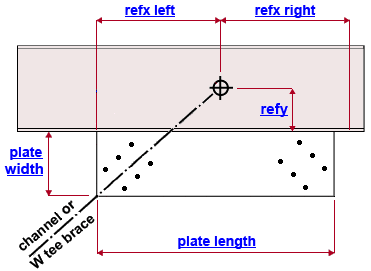"  Gusset 2 Point Square " connection design locks
Gusset 2 Point Square " connection design locks
| W tee or channel vertical braces field bolt directly to a shared gusset plate that shop attaches to a beam. The corners of the gusset plate (" |
|
|||
| " (gusset plate dimensions and location)  |
|
||
For 2-point and 3-point bracing, you probably will need to adjust equivalent settings on all of the braces that share the gusset in order to get the results you want.
User Defined Connections: Settings that are locked (
) in the user defined connection file will automatically be locked on the member edit window. You can, if you so choose, manually lock additional settings on the member edit window, and your changes will be retained, through multiple processes, so long as you do not change to a different connection then switch back to the original user defined connection.
Vertical Brace Edit: To change a setting, first set it to locked (
). Related settings that are unlocked (
) may be updated, and the "
Left/Right end limit state " calculations will be updated. Settings that are locked (
) will not be changed by connection design , even if doing so might prevent a connection failure.
Connection design locks :
| Locks not dimensioned or called out on the drawing are marked ( not depicted ). |
![]() Gusset 2 Point Square
Gusset 2 Point Square
(W tee or channel vertical braces, 2- or 3-point, to a beam)
Gusset plate dimensions and location
Plate thickness ( not depicted ): The " Material thickness " of the gusset plate.
Width: The distance (perpendicular to the beam's work line ) between the two longest edges of the gusset plate (see example ). For a non-sloping beam, this distance is vertical. The gusset plate " Width " can also be defined as the length of either of the two edges of the shared gusset plate that are perpendicular to the work line of the beam.
Length: The length of the framing edge of the gusset plate (which welds to the bottom flange of the supporting beam in the example shown). For a shared gusset plate that fastens to a non-sloping beam, this is the horizontal distance (parallel with the supporting beam's work line ) between the two vertical edges of the gusset plate. For a shared gusset that fastens to a sloping beam, this distance is measured parallel with the slope of the beam.
Refy: The positive (+) or negative (-) distance (perpendicular to the supporting beam's work line ) from the work point of the vertical brace to the framing edge of the gusset plate (which welds to the beam's bottom flange in the example shown). For a shared gusset plate that fastens to a non-sloping beam, this distance is vertical. Changing the " Refy " moves the gusset plate perpendicular to the work line of the beam, but does not move the holes on the plate.
Left Brace [ member number ]
Refx: The positive (+) or negative (-) distance (parallel with the supporting beam's work line ) from the work point of the left vertical brace to the corner of the gusset plate's framing edge that is closest to the left end of the beam. For a shared gusset plate that fastens to a non-sloping beam, this distance will be perfectly horizontal. Changing the " Refx " moves the gusset plate parallel with the work line of the beam, but does not move the holes on the plate.
Refx: The positive (+) or negative (-) distance (parallel with the supporting beam's work line ) from the work point of the right vertical brace to the corner of the gusset plate's framing edge that is closest to the right end of the beam. This works similar to the way that " Refx " works for the left vertical brace.







